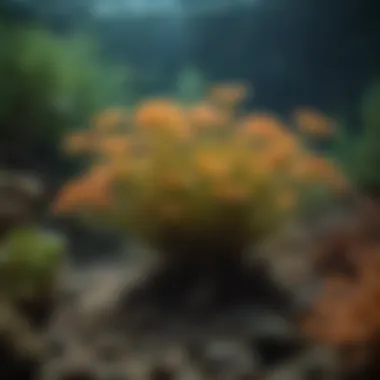The Ecological and Biochemical Importance of Ascophyllum nodosum


Intro
Ascophyllum nodosum, a type of brown algae, is often overlooked in discussions about marine biodiversity, yet it serves a monumental role both ecologically and biochemically. Found primarily along the Atlantic coasts of Europe and North America, this seaweed thrives in the intertidal zones, where land meets ocean. Its robust presence in these coastal environments not only contributes to the overall health of marine ecosystems but also reveals fascinating interactions with other marine organisms.
Despite its commonplace nature, Ascophyllum nodosum is a powerhouse of potential, especially when considered within various industrial applications. In agriculture, for instance, it acts as a natural fertilizer, promoting plant growth and soil health. Meanwhile, in the realm of pharmaceuticals and cosmetics, its unique biochemical properties offer promising avenues for exploration. In light of its multifaceted uses, understanding the ecological role and biochemical makeup of this algae has never been more pertinent.
By diving deep into the nuances surrounding Ascophyllum nodosum, this piece aims to illuminate not only its environmental significance but also its applications and potential future innovations. Compiling current research and insights, let’s unfold the layers that make this brown algae a subject worthy of scrutiny and admiration.
Prologue to Ascophyllum nodosum
Ascophyllum nodosum, commonly referred to as knotted wrack, stands out as an intriguing subject in marine biology. Its significance extends beyond being merely another brown algae; this species plays a pivotal role in marine ecosystems and human industries alike. Understanding the nuances of Ascophyllum nodosum can enlighten discussions on sustainability, ecological interactions, and innovative applications in agriculture and health.
This introduction sets the stage for discussing the taxonomy and classification of this species, as well as its wide-ranging geographical distribution.
Taxonomy and Classification
Ascophyllum nodosum is classified within the kingdom Plantae, specifically under the division Phaeophyta, which encompasses all brown algae. This species is part of the class Phaeophyceae and the order Fucales. Its genus, Ascophyllum, is notably unique as it contains only this particular species, making it a sole representative of its lineage. The binomial nomenclature for this species indicates not just its biological relatives but also provides essential information about its evolutionary history and ecological niches.
Geographical Distribution
Ascophyllum nodosum thrives in the cold waters of the North Atlantic, predominantly found along the coasts of North America and Europe. In particular, the shores of Newfoundland, the Bay of Fundy, and the western Irish coasts are havens for this algal species. Its adaptability to various tidal conditions allows it to flourish in intertidal and subtidal zones, often forming dense mats that serve as habitats for numerous marine organisms. The ecological footprint of this species cannot be overstated, as it significantly influences biodiversity and nutrient cycling in these regions.
"The distribution of Ascophyllum nodosum in temperate zones is a telltale sign of its ecological significance and resilience to environmental changes."
Moreover, its wide geographical presence highlights its importance in different climates, making it a potential candidate for studies focused on climate change and marine resilience.
Morphological Features
Understanding the morphological features of Ascophyllum nodosum is crucial in grasping its ecological and biochemical significance. These characteristics not only aid in the identification and classification of the species but also provide insights into its adaptations and ecological roles. The morphological aspects directly influence its interactions within ecosystems and its applications across various industries.
Plant Structure and Growth
Thallus Composition
The thallus of Ascophyllum nodosum is a key aspect of its structure, primarily composed of a core of algal cells surrounded by a robust layer of cell walls rich in alginates and fucoidans. This composition grants the algae mechanical strength and flexibility, allowing it to withstand the harsh conditions of its marine environment. One standout feature of its thallus is the air bladders that enable the plant to float, optimizing its exposure to sunlight for photosynthesis.
- Key Characteristics: The thallus can grow up to 2 meters in length, showcasing varied colors from olive green to brown, which helps in light absorption.
- Benefits: Its unique buoyancy aids in positioning itself at optimal depths for sunlight, facilitating effective photosynthesis and nutrient acquisition.
- Consideration: High alginate content makes it an attractive candidate for industrial extraction, used in food and pharmaceuticals.
Reproductive Organs
Ascophyllum nodosum produces both male and female reproductive organs, often referred to as conceptacles, located on the tips of its branches. Each conceptacle contains gametes that participate in sexual reproduction during specific seasonal conditions. The notable feature of these organs is the dual function they serve: they protect gametes from environmental stressors while facilitating reproduction.
- Key Characteristics: The conceptacles are quite distinctive, often appearing as bulbous protrusions on the fronds.
- Benefits: This arrangement ensures a higher likelihood of successful fertilization in dense populations, leading to prolific recruitment of young algae.
- Consideration: Seasonality of reproduction can limit the availability of gametes, making timing vital for successful growth and subsistence of the population.
Physiological Adaptations
Physiological adaptations of Ascophyllum nodosum play an essential role in its survival strategy, particularly its efficiency in light absorption and nutrient uptake, both critical for flourishing in varying marine environments.
Light Absorption
The ability of Ascophyllum nodosum to effectively absorb light is another cornerstone of its physiological adaptation. Its coloration contributes to optimal light capture, utilizing a mix of pigments like chlorophyll a and c, along with carotenoids.
- Key Characteristics: The broad surface area of the thallus maximizes light capture, establishing it as an efficient photosynthesizer.
- Benefits: This adaptability allows it to thrive in both shallow and deeper waters, adjusting its photosynthetic efficiency based on available light conditions.
- Consideration: In highly turbid waters, competition for light may limit growth if it cannot adjust quickly enough.
Nutrient Uptake
The nutrient uptake mechanism in Ascophyllum nodosum is notably efficient, enabling it to accumulate essential elements from seawater. Its surface, loaded with microstructures, increases contact area for nutrient absorption.
- Key Characteristics: Ascophyllum’s integration of active and passive uptake methods allows it to absorb a wide range of nutrients efficiently, including nitrogen and phosphorus.
- Benefits: This capability is vital for its growth in nutrient-poor environments, helping sustain large populations and diverse ecosystems.
- Consideration: However, its reliance on surrounding nutrient levels can be a double-edged sword if local waters suffer from pollution, affecting its health and growth.


"The physiological adaptation mechanisms that Ascophyllum nodosum exhibits make it not just a survivor, but a thriving participant in its aquatic ecosystem."
Ecological Significance
The ecological importance of Ascophyllum nodosum can’t be overstated. This brown algae plays a crucial role in the coastal ecosystems where it thrives, linking the various components of the marine food web while also functioning as a fundamental habitat. The multifaceted contributions of Ascophyllum nodosum impact both the local biodiversity and the health of ocean ecosystems.
Ecosystem Roles
Habitat Provider
Ascophyllum nodosum provides critical habitats for numerous marine organisms. This algae grows in dense beds along rocky shorelines, forming shelters for various species like fish, crabs, and mollusks. The density of these thalli creates microenvironments that offer safety and resources. It also acts as a nursery for juvenile fish, who find refuge among the fronds from predators.
One remarkable characteristic of this habitat provider is its ability to stabilize the substrate in turbulent waters. By anchoring firmly to rocks, Ascophyllum nodosum prevents erosion and fosters solid attachments for other marine organisms, creating a thriving ecosystem.
Although this habitat is advantageous, it does come with its challenges. Density can also lead to competition among species that seek to utilize this habitat, which can affect overall diversity if not managed properly.
Food Source
A significant aspect of Ascophyllum nodosum is its role as a food source. It is a primary food item for several herbivorous marine animals, including snails and sea urchins. The nutritional profile of the algae is rich in dietary fibers, vitamins, and minerals, making it an attractive and beneficial option in diets across various species.
The key characteristic here is its biomass, which translates to a sustainable food source that contributes to the food web's stability. Its unique feature, in contrast to other algae, is its high content of essential nutrients, which helps support the health and growth of herbivores, subsequently feeding larger predator species. However, one downside is that the overconsumption by certain grazers can lead to a decline in Ascophyllum beds, which would ultimately impact ecosystem health.
Inter-species Relationships
Competition
In the bustling undersea world, competition is a natural part of life. Ascophyllum nodosum competes with other intertidal algae for light, space, and nutrients. Its fast growth and ability to thrive in low-light conditions make it a formidable competitor. Such competition can lead to diverse strategies among species, influencing their evolutionary adaptations.
Highlighting this aspect of competition reflects the dynamic interactions within ecosystems. The unique adaptation of Ascophyllum nodosum to monopolize scarce resources can benefit its survival but can also reduce the diversity of species in its immediate vicinity. The trade-off between being dominant and allowing for a diverse ecosystem continues to be a significant point of research in marine biology.
Mutualism
Mutualism showcases a more harmonious aspect of inter-species relationships concerning Ascophyllum nodosum. This alga engages in mutualistic partnerships with a variety of organisms, including bacteria and fungi. These relationships enhance nutrient uptake and provide additional benefits like protection against pathogens.
The unique advantage of mutualism in this context is the enhanced health and vigor of the algae, which can improve its growth and resilience in fluctuating environmental conditions. These partnerships are crucial to maintaining the overall balance in the ecosystem. However, the reliance on specific partners means that changes in the environment, such as pollution or habitat destruction, can jeopardize these mutualistic ties, leading to unforeseen consequences for the algae and the species depending on it.
"Understanding the ecological significance of Ascophyllum nodosum sheds light on its vital role in maintaining the richness of marine biodiversity."
In summary, the ecological significance of Ascophyllum nodosum encompasses its roles as a habitat provider, a food source, and its intricate interrelationships with other species. Each aspect contributes to the overall stability and health of marine environments, making it an integral part of coastal ecosystems.
Biochemical Composition
The biochemical composition of Ascophyllum nodosum is a cornerstone of its significance in both ecological and industrial contexts. This brown algae is rich in diverse compounds, and understanding these biochemicals sheds light on its multifaceted roles in the environment and potential applications in various sectors.
Applications of Ascophyllum nodosum
The applications of Ascophyllum nodosum are extensive and showcase the versatility of this brown algae. It has a significant presence in agriculture, pharmaceuticals, and the cosmetic industry. Understanding these applications not only highlights the economic benefits but also emphasizes the sustainability aspects that come with using this natural resource.
Agricultural Uses
Soil Enhancers
In the realm of agriculture, soil enhancers made from Ascophyllum nodosum play an integral role. These enhancers improve soil structure and increase moisture retention, making them a valuable option for sustainable farming practices. A key characteristic is their ability to promote microbial activity, which can enhance nutrient cycling. This leads to healthier plant growth, proving them to be a go-to for eco-conscious farmers.
One unique feature of these soil enhancers is their natural composition, which allows for minimal environmental impact when compared to synthetic fertilizers. While their effectiveness can vary based on soil type and environmental conditions, they generally offer a low-risk and beneficial choice for improving soil health.
Biostimulants
Biostimulants derived from Ascophyllum nodosum have gained popularity as effective tools to enhance plant growth and resilience. These substances not only help plants to absorb nutrients more efficiently but also promote root development. The advantage of biostimulants is their ability to bolster plant stress responses, which can be crucial in challenging growing conditions.
In comparison to traditional fertilizers, these biostimulants offer a more sustainable option, with less risk of nutrient runoff. Their use can lead to better crop yields while reducing the dependence on chemical fertilizers. However, the variability in formulation means farmers should look at specific needs to achieve the best results.


Pharmaceutical Potential
Antimicrobial Properties
The antimicrobial properties of Ascophyllum nodosum have emerged as a fascinating area of research in the pharmaceutical field. The presence of bioactive compounds has shown potential in combating various bacteria and fungi. These properties make it a valuable resource in the development of natural antimicrobial agents, a rising interest in drug development due to growing antibiotic resistance.
A notable strength of these antimicrobial properties is the relatively low toxicity to human cells, offering a safer alternative compared to synthetic agents. However, it’s worth mentioning that further studies need to establish standard dosages and formulations for maximum efficacy.
Anti-inflammatory Effects
The anti-inflammatory effects of Ascophyllum nodosum are another area that holds promise. Various studies have indicated its potential in treating inflammatory conditions, both internally and externally. The compounds found in this algae can modulate the body’s inflammatory response, providing relief for conditions like arthritis and skin irritations.
This property makes Ascophyllum nodosum a desirable option in creating treatments that are almost natural, offering a gentle alternative to chemical medications. However, like its antimicrobial properties, more clinical trials are necessary to fully understand the range of its effects and how it can be best applied in therapeutic settings.
Cosmetic Industry Applications
Skin Hydration
In the cosmetic realm, the hydrating capabilities of Ascophyllum nodosum are well recognized. The polysaccharides, particularly alginates, provide a moisture-retaining effect that enhances skin hydration. This characteristic has made it a popular ingredient in various skincare products.
The unique feature of this algal extract is its ability to bind moisture, creating a barrier that protects the skin from environmental stressors while ensuring deep hydration. Accordingly, it is often used in formulations aimed at dry or sensitive skin. However, individual reactions can vary, and users should perform patch tests when trying new products featuring this ingredient.
Anti-aging Products
Anti-aging products featuring Ascophyllum nodosum capitalize on its antioxidant properties, which can help combat free radicals that contribute to skin aging. The natural composition makes it a favored choice among brands looking for eco-friendly ingredients.
One striking feature is its ability to promote skin elasticity and reduce the appearance of fine lines, making it a competitive player in the anti-aging market. Yet, while efficacy signs are promising, results might not be immediate, and consumer expectations need to be managed accordingly.
The diverse applications of Ascophyllum nodosum underscore its ecological and economic relevance, not just in traditional areas but also in the modern innovation landscape.
Conservation and Environmental Challenges
Conservation and environmental challenges represent a critical aspect of studying Ascophyllum nodosum. This brown algae is not only a bioresource but also an integral part of many marine ecosystems. The sustainability of this species hinges on our understanding of the myriad threats it faces. With increasing human activity and climate change, the natural habitats of Ascophyllum nodosum risk degradation. Hence, conserving these crucial marine environments is not just a wise choice; it’s necessary for ecological balance.
Threats to Habitat
Pollution
Pollution is a significant concern when discussing Ascophyllum nodosum habitats. Various pollutants, including heavy metals, plastics, and excess nutrients from agricultural runoff, degrade water quality and impact algal populations. Nutrient pollution, particularly, can lead to algal blooms that overshadow this seaweed, creating competition for sunlight and nutrients. Not to mention, the toxins associated with these blooms can damage the physiological processes of the algae.
"If pollution continues at this pace, it could be the straw that breaks the camel's back for many species, including Ascophyllum nodosum."
The uniqueness of pollution's impact lies in its multifaceted nature—it doesn’t just threaten the algae itself, but the entirety of the ecosystem it supports. For this article, understanding how pollution affects Ascophyllum nodosum helps illuminate the broader implications for marine biodiversity and health.
Climate Change Impacts
The effects of climate change on sea levels and ocean temperatures pose another serious threat to Ascophyllum nodosum. Warmer waters affect the growth and reproduction of this species, potentially altering reproductive cycles or shifting their geographic distribution. Additionally, ocean acidification can alter the calcium carbonate structures in marine ecosystems, further jeopardizing the habitats of this algae.
The prominence of climate change as a threat merits attention because it interacts with other environmental challenges. For instance, increased storm frequency could lead to physical destruction of coastal habitats, including areas rich in Ascophyllum nodosum. This underscores how climate change is not just a standalone issue but part of a complex web of environmental factors.
Preservation Efforts
Preservation efforts for Ascophyllum nodosum take form in various tiers, significant among them are sustainable harvesting practices and the development of regulatory policies that govern its collection and use. These efforts aim to mitigate the challenges posed by pollution and climate change.
Sustainable Harvesting
Sustainable harvesting of Ascophyllum nodosum emphasizes responsible collection techniques that minimize ecological impact. By adopting practices that ensure a continued supply of algal biomass, we can help maintain balance in the ecosystems where this species thrives. Educating communities and stakeholders about sustainable practices is crucial. It connects economic activities with ecological stewardship, ensuring that harvesting doesn't lead to the depletion of this valuable resource.
The advantage of sustainable harvesting is that it allows for continuity in supply while protecting the ecosystem's integrity. In this article, emphasizing this practice presents a hopeful alternative to the challenges faced by Ascophyllum nodosum and encourages more environmentally conscious behaviors in harvesting.


Regulatory Policies
Effective regulatory policies can serve as a backbone for conservation efforts. These policies can set limits on harvesting quantities, prohibited zones, and required sustainable practices, thereby guiding the interaction between humans and the natural ecology of Ascophyllum nodosum.
Key characteristics of sound regulatory policies include scientific backing and community engagement. Policies derived from research data can adapt to biological and ecological conditions, ensuring they're relevant and effective. Community engagement fosters compliance and empowers local ecosystems' stewards.
Evaluating regulatory policies underpins the discourse on conservation, positioning them as mechanisms for promoting long-term ecological health in marine environments. Without such frameworks, the challenges of pollution and climate change could render even the most environmentally friendly practices ineffective.
Conservation of Ascophyllum nodosum in face of threats demands a multidisciplinary approach, combining policy, community engagement, and sustainable practices to sustain this invaluable resource for future generations.
Future Research Directions
As we delve into the future of Ascophyllum nodosum research, the focus shifts toward topics that could dramatically enhance its utility and impact across various fields. The significance of exploring new techniques and genetic insights cannot be overstated. By prioritizing advancements in extraction processes and understanding genetic dynamics, future studies can unlock potential we have only begun to scratch the surface of.
Innovations in Extraction Techniques
The demand for Ascophyllum nodosum in industries such as agriculture and pharmaceuticals craves innovative approaches for its effective extraction. Current methods can be somewhat cumbersome, often requiring harsh chemicals that may compromise the integrity of the algal compounds. By developing milder, bio-friendly extraction techniques, researchers stand to offer a more sustainable route, which will not only boost yields but also ensure that the quality remains intact.
Some exiting avenues for exploration include:
- Cold Extraction Methods: Employing lower temperatures to preserve bioactive compounds.
- Enzymatic Techniques: Utilizing enzymes to break down cell walls, enhancing extraction without chemical solvents.
- Ultrasound-Assisted Extraction: Leveraging sound waves to increase the efficiency of nutrient extraction.
These methods not just enhance extraction efficiency; they also align well with a growing environmental consciousness, paving the way towards sustainable industrial practices.
Genetic Studies
Gene Expression Analysis
Understanding the gene expression of Ascophyllum nodosum opens doors to comprehending how it adapts to various environmental conditions. By analyzing which genes are turned on or off, researchers can piece together how the algae respond to stressors such as salinity changes and thermal variations. This analysis can aid in identifying traits crucial for survival, helping to strengthen the resilience of the species in its natural habitats.
The distinct aspect of Gene Expression Analysis lies in its capacity to reveal:
- Adaptation Mechanisms: Insights into how this alga copes with fluctuating environmental conditions.
- Potential for Breeding Programs: Identifying desirable traits for cultivation in aquaculture or for industrial applications.
While this technique holds immense promise, challenges include the need for sophisticated equipment and expertise, which can limit accessibility for some research institutions.
Biotechnological Applications
The Biotechnological Applications of Ascophyllum nodosum are profound, particularly in creating value-added products from what nature provides. Innovations in utilizing algal extracts for various biotechnological purposes are quickly gaining traction. From biofuel production to serving as probiotics in livestock feed, the versatility is remarkable.
The key characteristic driving interest in this area stems from:
- Renewable Resource Potential: Algae, like Ascophyllum nodosum, grow quickly and can be harvested without depleting land resources.
- Health and Nutrition: Deriving supplements for both human and animal health, tapping into its rich biochemical catalogue.
However, the unique feature of Biotechnological Applications can also introduce complexities, such as the need for rigorous testing to ensure any product derived is safe and effective. This process can be both time-consuming and costly but is necessary for substantiating claims amid increasing consumer awareness.
"As the tide of innovation rises, so too does the potential for a species often overlooked. Ascophyllum nodosum could lead the charge in sustainable practices across various sectors."
By continuously probing these future research directions, we not only fortify our understanding of Ascophyllum nodosum but also ensure its relevance in addressing pressing global challenges.
The End
The conclusion serves as a crucial aspect of our exploration of Ascophyllum nodosum. It provides a reflective summary, encapsulating the main findings and underscoring the significance of this brown algae species in both ecological and industrial contexts.
Summary of Findings
Throughout the article, we have traversed the intricate landscape of Ascophyllum nodosum, from its unique morphological traits to its essential ecological roles. Its capacity to thrive in various habitats highlights its adaptability to environmental challenges. Moreover, its high biochemical value offers promising applications across multiple industries, which we discussed in detail. Key takeaways include:
- Ecosystem Services: Ascophyllum nodosum plays an indispensable role in coastal ecosystems, serving as habitat and offering food for various marine organisms.
- Biochemical Riches: The algae is a treasure trove of nutrients, with compounds like alginates and fucoidans being particularly important in agriculture and pharmaceuticals.
- Environmental Impact and Conservation:The ongoing threats, such as pollution and climate change, necessitate robust conservation efforts to preserve its habitats.
This summary encapsulates not just the biological significance of Ascophyllum nodosum, but also its potential as a sustainable resource, providing benefits not just to ecosystems but to humanity as well.
Reassessment of Ascophyllum nodosum's Importance
The importance of Ascophyllum nodosum can not be overstated. It stands at the intersection of ecological integrity and human innovation. As we move forward, it's essential to reassess our relationship with this species. Key points to ponder include:
- Ecological Balance: Maintaining healthy Ascophyllum nodosum population is critical for preserving biodiversity and ecosystem stability in coastal areas.
- Research and Innovation: Ongoing research into its genetic makeup and biochemical properties could lead to novel applications, enhancing our current understanding and utilization of this algae.
- Sustainable Practices: Emphasizing sustainable harvesting and usage of Ascophyllum nodosum will ensure that future generations can benefit from its myriad properties without jeopardizing the marine environment.







